Ajax Modern Random Chess
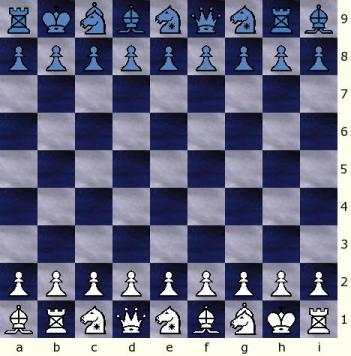
Ajax Modern Random Chess is just Modern Random Chess played with Ajax Chessmen and with two extra Ajax Ministers drops à la Seirawan Chess.
NOTE: The diagrams on this page, and on the Game Courier Preset, show a regular Prime Minister (Bishop+Knight), when in fact it is an Ajax Prime Minister (Bishop+Knight+Wazir). When the Ajax Prime Minister symbol (a Bishop+Knight symbol with a Wazir cross inside) is available, all the diagrams and Game Courier will be updated accordingly. For the mean time, remember that the Ajax Prime Minister has a one-step non-capturing orthogonal step.
Setup
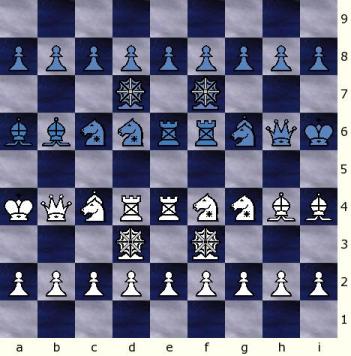 ....
.... 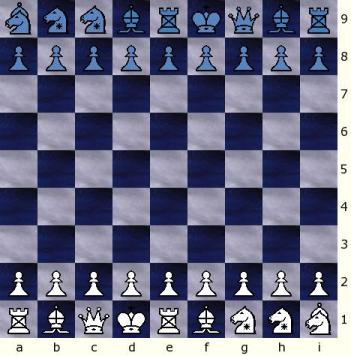
All pieces are randomly placed in the player’s first rank, with the only restriction that the King must be between the two rooks. It is possible for both Bishops to be on the same color squares (dark or light squares). The opponents’ pieces are placed with reverse symmetry (White’s piece at a1 is equivalent to Black’s i9, White’s b1 to Black’s h9, White’s c1 to Black’s g9, White’s d1 to Black’s f9, and so on…)
There is no need for the Bishop Adjustment rule in Ajax Modern Random Chess as Bishops are free to swap to opposite color squares at any time thanks to their one-step non-capturing orthogonal move.
There are 15,120 different legal starting positions in Ajax Modern Random Chess.
Reverse Symmetry
In a reverse symmetrical setup the piece at the square a1 for White, is the same as the piece at i9 for Black. The piece at b1 for White is the same as the one at h9 for Black, and so on. The Pawns are in the second row of each player’s side.
Look at the sample Ajax Modern Random Chess positions below, from both White and Black’s point of view:
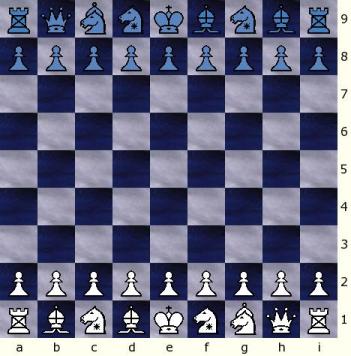 ....
....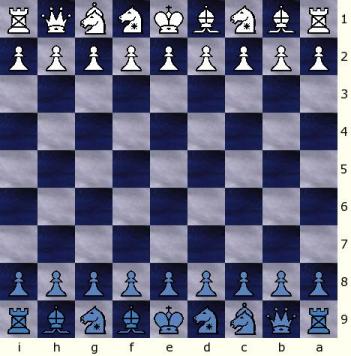
They look identical from both White’s and Black's point of view. That's reverse symmetry!
Pieces
Ajax Chess pieces inspired by the Man or Commoner from Courier Chess are used.All regular minor chess pieces (Rook, Bishop and Knights) move as in Orthodox Chess, with the additional feature that they can also move (but not capture! see below) as Courier Chess' Man (or Commoner): one square in any arbitrary direction, just like a King:
This means that Rooks get an additional one-step diagonal move (Ferz), Bishops get an additional one-step orthogonal move (Wazir), and Knights get all Man (Commoner) one-step moves.
Like a Bishop, the Ajax Prime Minister get an additional one-step orthogonal move (Wazir).
There is a catch though to this new "adopted" move to the Orthodox Chess pieces! They are not allowed to capture with their new "adopted" moves. So Rooks are not allowed to capture on their diagonal move, the Bishops and Prime Ministers can't capture on their orthogonal moves and Knights are not allowed to capture on their one-square moves.
The additional "adopted" Commoner moves are intended to easily allow a Prime Minister, Rook, Bishop and Knight to move to a new outpost where they can carry their orthodox attacks. They can also use their "adopted" moves to block an enemy attack.
The precedent for the Ajax-Pieces not being able to capture with their adopted Commoner moves is the Pawn. The Pawn moves in one direction (straight forward) and captures in another (diagonally forward).
The Ajax-Minister
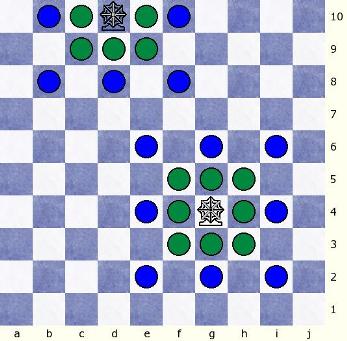
The Minister (enhanced Man or Commoner) is an additional minor piece to the Ajax Chessmen set that can move AND capture on their one-square moves (just like a Man, circles in green above) or can also do a two-step leap in any direction (Alfil+Dababah - circles in blue above).
The Ajax Minister is the latest re-incarnation of a piece that has been known before as Pasha (Paulovits's Game by István Paulovits - c.1890), Squire (Renniassance Chess by Eric V. Greenwood - 1980), Jumping General (Grand Shatranj) or Jumping King (Atlantean Barroom Shatranj) [both by Joe Joyce - 2006], and Mastodon or Mammoth (Mastodon and Mammoth Chess by Mats Winter 2006).
Pawns
Pawns can play one or two squares in their initial move. They capture one square diagonally as in regular chess and may promote to any piece (Queen, Prime Minister, Rook, Minister, Bishop or Knight) upon reaching their last rank.Rules
Initial Placement of the Ajax-Ministers
When a player first moves a piece from its original square, that player has the option of placing a Minister on the vacated square, as part of the player's move.Example, if one of the player's initial Bishop's move was Be1-g3, he can place a Minister on the vacated e1. The algebraic notation for the move and drop would be: Bg3(Me1)
Players have nine opportunities to drop the Ministers, one for each time a piece moves from it's original square. If a player fails to drop a Minister during the initial move of one of the eight initial pieces, the unplaced Minister (or Ministers) remain out of play.
When a player castles, the Ministers may be placed on either the King or Rook starting squares, but not on both. Two moves are required to bring both Ministers into play.
Sample Minister Drops
ARC - Ajax Random Chess - BRKRNQNB [left diagram]José Carrillo (CAN) - Attack Hippo (USA)
CV Game Courier, August 2009
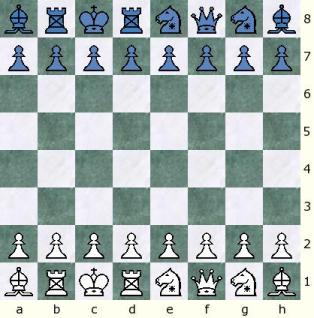 ...
...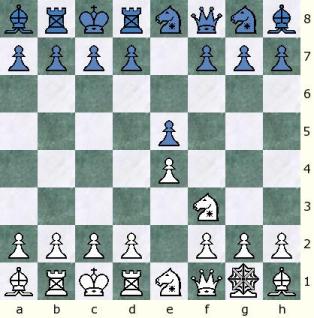 ...
...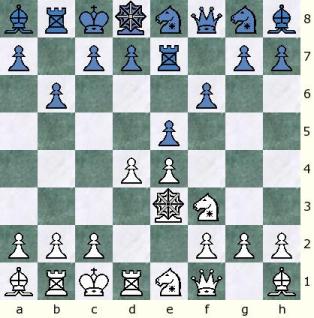
1.e4 e5 2.Ngf3(Mg1) [middle diagram] b6 3.Me3 f6 4.d4 Re7(Md8) [right diagram]
Other Rules
The goal of the game is to checkmate the opponent's King, as in Orthodox Chess.Rules for check, checkmate, stalemate, en passant, 50-move draw and Threefold Repetition Draw are like in Orthodox Chess.
Castling
The Ajax Modern Random Chess castling
rules are based in the Fischer Random Chess rules.
In Ajax Modern Random Chess, depending on the pre-castling position on the castling King and Rook, the castling manoeuvre is performed by one of these four methods:
- Double-move castling: By on one turn making a move with the king and a move with the rook.
- Transposition castling: By transposing the position of the king and the rook.
- King-move-only castling: By making only a move with the king.
- Rook-move-only castling: By making only a move with the rook.
After castling, the rook and king's final positions are exactly the same positions as they would be in Maura’s Modern Chess. Thus, after c-castling (notated as O-O-Oc), the King is on the c-square (c1 for White and c9 for Black) and the Rook is on the d-square (d1 for White and d9 for Black). After g-castling (notated as O-O-Og), the King is on the g-square (g1 for White and g9 for Black) and the Rook is on the f-square (f1 for White and f9 for Black).
This table shows where the King and Rook end up and the notation for each type of castling.
| White castles a-side | c-castling | O-O-Oc | Kc1, Rd1 |
|---|---|---|---|
| White castles i-side | g-castling | O-O-Og | Kg1, Rf1 |
| Black castles a-side | c-castling | O-O-Oc | Kc9, Rd9 |
| Black castles i-side | g-castling | O-O-Og | Kg9, Rf9 |
However, castling may only occur under the following conditions, which are extensions of the standard rules for castling:
- Unmoved: The King and the castling Rook must not have moved before in the game, including a previous castling.
- Un-attacked: All of the squares between the king's initial and final squares (including the initial and final squares) must not be under attack by any opposing piece.
- Vacant: All the squares between the king's initial and final squares (including the final square), and all of the squares between the rook's initial and final squares (including the final square), must be vacant except for the king and castling rook.
- Castling cannot capture any pieces.
- The king and castling rook cannot "jump" over any pieces other than each other.
- A player may castle at most once in a game.
- If a player moves his king or both of his initial rooks without castling, he may not castle during the rest of the game.
- In some starting positions, some squares can stay filled during castling that would have to be vacant in Modern Chess. For example, after c-castling (O-O-Oc), it's possible for to have a, b, and/or e still filled, and after g-castling (O-O-Og), it's possible to have e, h and/or i filled.
- In some starting positions, the king or rook (but not both) do not move during castling.
- In some starting positions, castling can take place as early as the first move.
- The king may not be in check before or after castling.
- The King cannot move through check.
- The King cannot jump over his own rook if and when said rook stands on a “checked†square.
- Castling in MRC is symmetric to either side of the board. MRC Castling is like the Orthodox long castling (O-O-O) but to either side.
Notes
Game Courier Preset
 ....
.... ....
....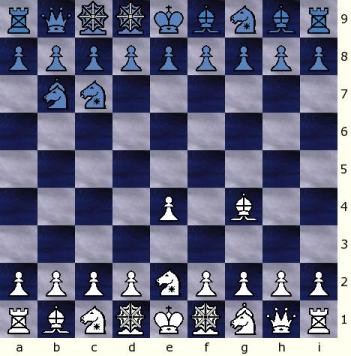
Initially in the Game Courier preset, all pieces (including the Ministers) will be placed in the middle of the board on the 3rd to 7th ranks (above left).
When the game is created, the pieces (minus the Ministers) will be randomly placed on the players' 1st rank, and the Ministers will disappear (sample random position above middle).
To drop a Minister after an initial piece move, add: "; M-xx" (for White) or "; m-xx" (for Black) after the move of the initial piece. [xx is the initial square of the piece just moved]
After playing the sequence: 1.e4 Nc7(Md9) 2.Bg4(Md1) PMb7(Mc9) 3.Nfe2(Mf1) one arrives at the above diagram on the right, having dropped all 4 Ajax Ministers.
Game Courier Preset
Ajax Modern Random ChessGame Courier Logs
Game Courier Logs for Games of Ajax Modern Random ChessTo see actual games that have been played on-line, follow the link above.
Ajax Random Chess (ARC) was created by José Manuel Carrillo-Muñiz, from Puerto Rico in 2009.
Chess Variants by the Author:
- Modern Random Chess (9x9)
- Contemporary Random Chess (8x8)
- Prime Ministers Chess (9x8)
- Modern Capablanca Random Chess (10x8)
- Modern English Random Chess (10x10)
- Pseudo-Modern Random Chess (9x9)
- Chess8400 (9x9)
- Prime Ministers Contemporary Random Chess (8x8)
- Prime Ministers Random Chess (9x8)
- International Contemporary Random Chess (10x10)
- International Fischer Random Chess (10x10)
- Courier Chess Moderno (12x8)
- Mini Courier Chess Moderno (10x8)
- Silver Elephant Chess (10x8)
- Modern Ministers Courier Chess (11x8)
- Ajax Chess (10x10)
- Ajax Modern Random Chess (9x9)
- Ajax-Capablanca Chess (10x8)
- Ajax Random Chess (8x8)
- Partnership Chaturanga (8x8)
- Korean Random Chess (9x10)
Other Pages by the Author:
- How to Generate Random Positions
- The Bishop Adjustment Rule
- The Modern Principles
- Reverse Symmetry
- The Prime Minister
- The Courier Elephant
- The 10x8 Variants
- Modern Chess Preset
- Makruk (Thai Chess) Preset
 This 'user submitted' page is a collaboration between the posting user and the Chess Variant Pages. Registered contributors to the Chess Variant Pages have the ability to post their own works, subject to review and editing by the Chess Variant Pages Editorial Staff.
This 'user submitted' page is a collaboration between the posting user and the Chess Variant Pages. Registered contributors to the Chess Variant Pages have the ability to post their own works, subject to review and editing by the Chess Variant Pages Editorial Staff.
By Jose Carrillo.
Web page created: 2009-09-20. Web page last updated: 2009-09-20